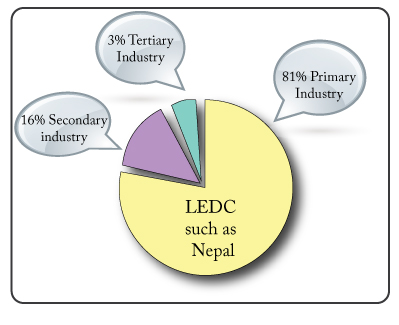Development Indicators
There are many ways to try and establish how developed a country is in relation to other countries. Economic indicators have traditionally been used but they provide a limited insight. Increasingly social indicators and indexes that combine numerous factors are used.
You should be able to define and describe the advantages and limitations of various indicators.
per capita is often used for economic indicators which means per person (total divided by the population). This has several advantages:
- it allows a meaningful comparison of countries with different population sizes.
- it allows year on year comparisons since it takes out the effects of population growth/decline.
GNP/capita: value of goods and services produced in a year by a country/person (including overseas earnings and subtracting foreign firms in the country).
Literacy rate: the % of adults that can read and write.
Life expectancy: the average age a person can expect to life to in a country at their year of birth.
Human Development Index (HDI): This is an index that takes into account life expectancy, GNP/capita and educational attainment.
Employment Structures
Industrial Sectors
Primary industry: extraction of raw materials / farming & fishing.
Secondary industry: manufacturing and construction.
Tertiary industry: service provision.
The tertiary sector is wide ranging and can differ between high and low value jobs. Cleaners, waiters, retail workers tend to have low incomes. Bankers, software developers, accountants earn high incomes.
Quaternary sector: this sector is based around high-tech research and development and is associated with pharmecutical and technology firms.



Employment Structures & Development
Employment structures represent the proportion of a countries workers employed in the different industrial sectors.
LEDC Employment Structure
LEDCs typically have a percentage of primary industry for several reasons:
- Low capital costs/requirements for fishing and farming.
- Abundance of natural resources in many LEDC countries
- Low level of education needed to work in these industries, skills are passed on to younger generations as they start working.
- Generate foreign income as many products are sold to other countries.
LEDCs have smaller secondary and tertiary industries due to the cost of establishing them and the need for skilled workers in technology, finance, medicine etc.

MEDC Employment Structure
Developed countries tend to have very small proportions of their population employed in primary industry. This is mainly due to significant mechanisation leading to high output with lower labour requirements.
They also import many of the raw materials they need from overseas.
Their secondary industry has been declining as manufacturers have relocated to regions in Asia where wages are lower and the raw materials are closer.
Containerisation has led to a drastic fall in the price of transportation and so manufactured goods can be imported cheaply.
They have large tertiary sectors based on high value industries such as computing software, financial services, architecture and engineering. These industries generate large profits.
Many developed countries also have large public sector service industries in health, education and public administration.




